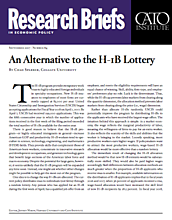Rather than allocate H‑1Bs randomly, USCIS could potentially improve the program by distributing H‑1Bs to the applicants who have received the largest wage offers. The intuition behind this approach is simple: in a market economy, the wage reflects the marginal productivity of labor, meaning the willingness of firms to pay for an extra worker. It also reflects the scarcity of the skills and abilities that the worker is bringing to the market. Loosely speaking, more productive workers earn higher wages. If policymakers want to attract the most productive workers, wage-based H‑1B allocation would be more effective than a random lottery.
The immediate result of changing the H‑1B allocation method would be that new H‑1B entrants would be substantially more skilled. They would also be paid higher wages accordingly. Skill differences between allocation methods are much greater when the proportion of H‑1B applicants who receive visas is smaller. For example, available information on the distribution of H‑1B applicants implies that in fiscal years 2016 and 2017, when 36 percent of applicants received a visa, wage-based allocation would have increased the skill level of new H‑1B recipients by 28.5 percent. In fiscal year 2018, when 42.7 percent of applicants received a visa, the skill gap between allocation methods would have been 24 percent.
Importantly, those skill differences grow over time. A person can work in the United States on H‑1B status for up to six years, and many H‑1B workers use the program as a steppingstone to permanent residency. Furthermore, the accumulation of skills serves to increase aggregate economic output and productivity as well. Altogether, estimates suggest that when only 36 percent of H‑1B applicants receive visas, GDP could rise by over $40 billion over a six-year period with a wage-based H‑1B allocation system.
This analysis is a starting point that imposes many simplifying assumptions. For example, it does not account for technological gains that would augment the benefits of ability-based H‑1B allocation. And as a long-run model, it does not measure the possibility for welfare-reducing unemployment spells.
One challenge might be that the change in allocation method would alter firm behavior. First, consider compositional issues in the absence of changes in behavior. Occupational and country composition between allocation methods would not differ much: data show that the demographic composition of the H‑1B population is quite similar to the composition of the top 36 percent of recipients (who are presumably similar to the top 36 percent of applicants). Visas would still be concentrated among Indian and computer-related workers in both methods. Ability-based distribution would lead to more computer, architecture, and engineering workers, but fewer foreign managers. The proportion of Indian and Chinese H‑1B recipients would rise, but the share of other Asian groups would fall.
But how might firm behavior change? One possibility is to recognize that under the current system, employers cannot effectively choose the foreign workers they wish to hire. If a company were to extend 100 job offers, it could expect to be able to hire 36 of its prospective employees, but the company would have no role in determining which 36 workers those would be. Under ability-based allocation, in contrast, the company could rank its preferences by extending higher wage offers to the higher-ability workers. This would, in effect, help ensure that workers are paid a wage that more accurately reflects their economic productivity. Doing so would help assuage criticisms that firms use the H‑1B workers to exploit foreign labor and undercut wages paid to foreign and domestic workers alike. Whether this would imply greater or fewer workers from specific countries or occupations is a speculative question. More certain is that it would restore market forces, thus incentivizing firms to pay wages that reflect labor productivity.
A second challenge might be on the ease of implementation. This seems easy to overcome. The H‑1B applications include wage offers, and USCIS already records that information. An ability-based allocation method would simply require USCIS to sort applications on wages and award visas to the top offers. If a large number of offers cluster near the wage cut-off, USCIS could institute a lottery for those workers. That is, a mixed system could be used in which the top wage earners receive a visa, while a lottery is used for people with mid-range wage offers.
For better or worse, the 85,000 annual cap on new H‑1B recipients is unlikely to rise in the near future. Thus, it might be more fruitful to consider how other changes to the program, while keeping the cap fixed, could improve the American economy. One such change is in the allocation method—allow firms to hire the highest-ability foreign workers instead of a random assortment of foreign workers who qualify for the program. The system would be easy to implement, would restore market forces in companies’ hiring efforts, and improve American GDP and productivity.
NOTE:
This research brief is based on Chad Sparber, “An Alternative to the H‑1B Lottery,” May 2017, http://www.sole-jole.org/17178.pdf.

